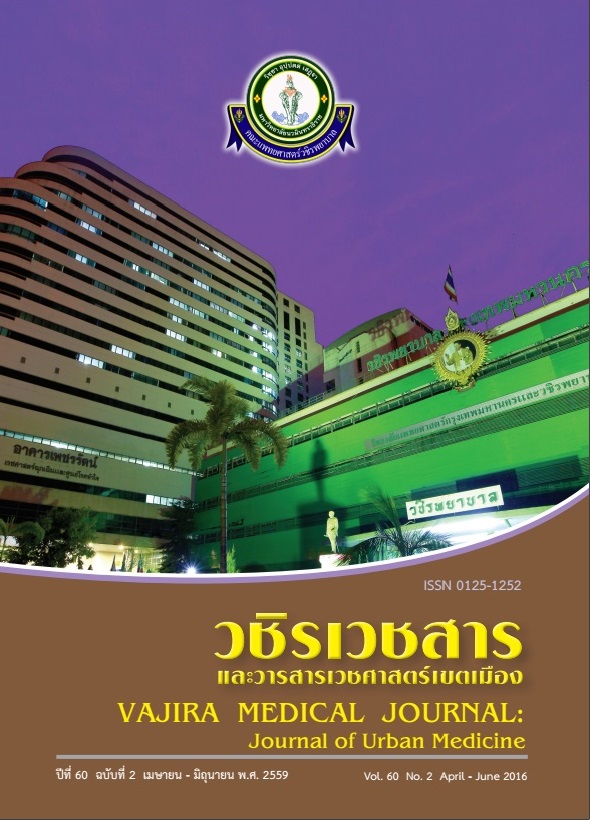Pediatric Pain
Main Article Content
Abstract
Pain can be classified according to duration and pathophysiology. Pain expression in children depends on age. In young children with pain who cannot communicate, behavioral change should be observed. Older children may express their own pain severity. Pain assessment tools can be used in various age to evaluate pain severity and treatment intervention. Treating pain in children using two-step strategy and adjuvants may be useful. Procedural pain in neonate have potential for deleterious consequences which can be prevented and managed by both pharmacological and non-pharmacological treatments.
Downloads
Download data is not yet available.
Article Details
How to Cite
Vitayaburananont, P., & Chotisukarat, H. (2016). Pediatric Pain. Vajira Medical Journal : Journal of Urban Medicine, 60(2), 135–145. retrieved from https://he02.tci-thaijo.org/index.php/VMED/article/view/194502
Section
Review Articles
References
1. Loeser JD, Treede RD. The Kyoto protocol of IASP Basic Pain Terminology. Pain. 2008, 137: 473–7.
2. Anand KJ, Craig KD. New perspectives on the definition of pain. Pain. 1996; 67: 3–6.
3. van Dijk A, McGrath PA, Pickett W, Van Den Kerkhof EG. Pain prevalence in 9-13-year-old school children. Pain Res Manag. 2006; 11: 234–40.
4. Perquin CW, Hazebroek-Kampschreur AA, Hunfeld JA, Bohnen AM, van Suijlekom-Smit LW, Passchier J,et al. Pain in children and adolescents: A common experience. Pain. 2000; 87(1): 51–8.
5. Huguet A, Miro J. The severity of chronic pediatric pain: An epidemiological study. J Pain. 2007; 9: 226–36.
6. Goodman JE, McGrath PJ. The epidemiology of pain in children and adolescents: A review. Pain. 1991; 46: 47-264.
7. McGrath PJ, Craig KD. Development and psychological factors in children’s pain. Ped Clin N Am. 1989; 36: 823-36.
8. von Baeyer CL, Spagrud LJ. Systematic review of observational (behavioral) measures of pain for children and adolescents aged 3 to 18 years. Pain. 2007; 127: 140-50.
9. Suraseranivongse S, Kaosaard R, Intakong P, Pornsiriprasert S, Karnchana Y, Kaopinpruck J, et al. A comparison of postoperative pain scales in neonates. Br J Anaesth. 2006 Oct; 97(4): 540-4.
10. Suraseranivongse S, Montapaneewat T, Manon J, Chainchop P, Petcharatana S, Kraiprasit K. Cross-validation of a self-report scale for postoperative pain in school-aged children. J Med Assoc Thai. 2005; 88(3): 412-8.
11. Suraseranivongse S, Santawat U, Kraiprasit K, Petcharatana S, Prakkamodom S, Muntraporn N, Cross-validation of a composite pain scale for preschool children within 24 hours of surgery. Br J Anaesth. 2001; 87: 400-5.
12. Saarto T, Wiffen PJ. Antidepressants for neuropathic pain. Cochrane Database Syst Rev. 2007; 4: CD005454.
13. Hetrick S, Merry S, McKenzie J, Sindahl P, Proctor M. Selective serotonin reuptake inhibitors (SSRIs) for depressive disorders in children and adolescents. Cochrane Database Syst Rev. 2007; 3: CD004851.
14. Slater R, Cantarella A, Gallella S. Cortical pain responses in human infants. J Neurosci. 2006; 26(14): 3662-6.
15. Anand KJ, Aranda JV, Berde CB. Summary proceedings from the neonatal pain-control group. Pediatrics
2006117 (3 Suppl 1) S9-S22.
16. Morrow C, Hidinger A, Wilkinson-Faulk D. Reducing neonatal pain during routine heel lance procedures. MCN Am J Matern Child Nurs. 2010; 35(6): 346-54
17. Harrison D, Beggs S, Stevens B. Sucrose for procedural pain management in infants. Pediatrics. 2012; 130(5): 918-25.
2. Anand KJ, Craig KD. New perspectives on the definition of pain. Pain. 1996; 67: 3–6.
3. van Dijk A, McGrath PA, Pickett W, Van Den Kerkhof EG. Pain prevalence in 9-13-year-old school children. Pain Res Manag. 2006; 11: 234–40.
4. Perquin CW, Hazebroek-Kampschreur AA, Hunfeld JA, Bohnen AM, van Suijlekom-Smit LW, Passchier J,et al. Pain in children and adolescents: A common experience. Pain. 2000; 87(1): 51–8.
5. Huguet A, Miro J. The severity of chronic pediatric pain: An epidemiological study. J Pain. 2007; 9: 226–36.
6. Goodman JE, McGrath PJ. The epidemiology of pain in children and adolescents: A review. Pain. 1991; 46: 47-264.
7. McGrath PJ, Craig KD. Development and psychological factors in children’s pain. Ped Clin N Am. 1989; 36: 823-36.
8. von Baeyer CL, Spagrud LJ. Systematic review of observational (behavioral) measures of pain for children and adolescents aged 3 to 18 years. Pain. 2007; 127: 140-50.
9. Suraseranivongse S, Kaosaard R, Intakong P, Pornsiriprasert S, Karnchana Y, Kaopinpruck J, et al. A comparison of postoperative pain scales in neonates. Br J Anaesth. 2006 Oct; 97(4): 540-4.
10. Suraseranivongse S, Montapaneewat T, Manon J, Chainchop P, Petcharatana S, Kraiprasit K. Cross-validation of a self-report scale for postoperative pain in school-aged children. J Med Assoc Thai. 2005; 88(3): 412-8.
11. Suraseranivongse S, Santawat U, Kraiprasit K, Petcharatana S, Prakkamodom S, Muntraporn N, Cross-validation of a composite pain scale for preschool children within 24 hours of surgery. Br J Anaesth. 2001; 87: 400-5.
12. Saarto T, Wiffen PJ. Antidepressants for neuropathic pain. Cochrane Database Syst Rev. 2007; 4: CD005454.
13. Hetrick S, Merry S, McKenzie J, Sindahl P, Proctor M. Selective serotonin reuptake inhibitors (SSRIs) for depressive disorders in children and adolescents. Cochrane Database Syst Rev. 2007; 3: CD004851.
14. Slater R, Cantarella A, Gallella S. Cortical pain responses in human infants. J Neurosci. 2006; 26(14): 3662-6.
15. Anand KJ, Aranda JV, Berde CB. Summary proceedings from the neonatal pain-control group. Pediatrics
2006117 (3 Suppl 1) S9-S22.
16. Morrow C, Hidinger A, Wilkinson-Faulk D. Reducing neonatal pain during routine heel lance procedures. MCN Am J Matern Child Nurs. 2010; 35(6): 346-54
17. Harrison D, Beggs S, Stevens B. Sucrose for procedural pain management in infants. Pediatrics. 2012; 130(5): 918-25.


